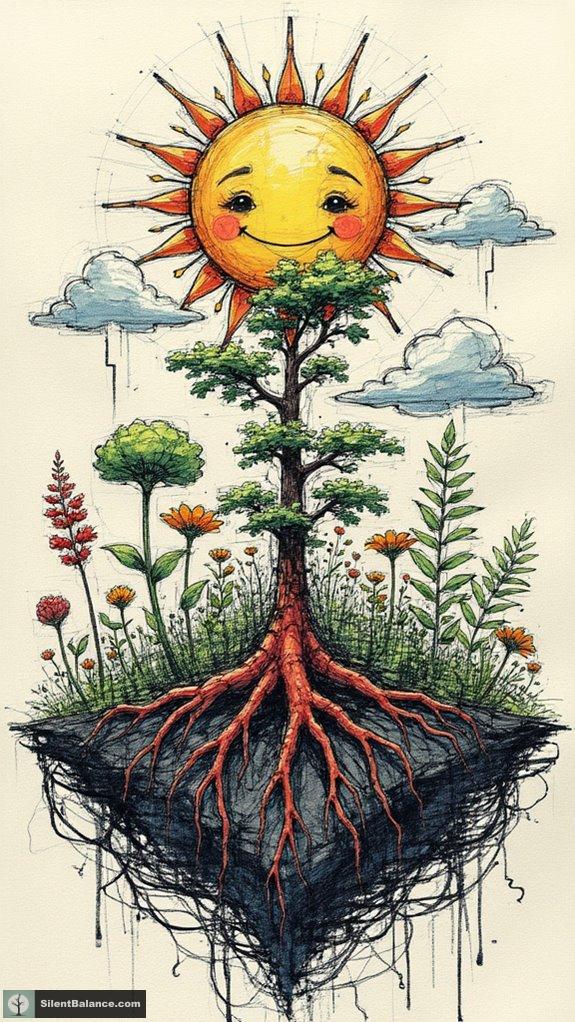The Dance of Mycorrhizal Networks: Competition or Cooperation?
In the labyrinth of mycorrhizal networks, life uncovers profound connections beneath our feet.
I remember witnessing a thriving forest where trees intertwined, showcasing the stunning symbolism of trees as an embodiment of strength and unity. As I stood there, I felt the rhythm of cooperation pulsating through the roots, the essence of my work on the blog Silent Balance coming alive. Here, competition doesn’t eliminate vitality; it crafts a resilient community.
In one memorable hike, I stumbled upon a struggling sapling cradled by a towering oak. The nurturing embrace of its older neighbor was a perfect reminder: in nature, both competition and cooperation can coexist beautifully.
It’s a wild world out there, isn’t it? These networks shape ecosystems, teaching us that every relationship—be it mutual or competitive—plays a vital role in survival. Are you as fascinated by this intricate balance as I am?
Quick Takeaways
- Mycorrhizal networks facilitate both competition and cooperation, allowing plants to access nutrients while simultaneously vying for resources.
- Established plants often monopolize nutrient access through mycorrhizal networks, disadvantaging younger seedlings and intensifying competition.
- Plants can recognize their kin, prioritizing resource sharing among relatives to enhance cooperative benefits and promote network efficacy.
- The balance between cooperation and competition impacts plant community health, influencing biodiversity and ecosystem resilience.
- Cooperative interactions within these networks foster mutual support, while competitive dynamics can lead to inequalities in resource allocation among different plant species.
The Role of Common Mycorrhizal Networks in Amplifying Competition

When you dive deep into the world of Common Mycorrhizal Networks (CMNs), you’ll discover they do more than just connect plants—they spark competition like a tattoo needle on skin.
Think about it: these networks link host plants and let fungi access diverse carbon sources. This boosts the fungus’s bargaining power while plants scramble for nutrients like artists eyeing flash designs. The fungi’s ability to discriminate between high and low-quality host plants boosts their advantage in this competition.
It’s a brutal game where those investing carbon hope to score big, but there’s a twist—better-connected plants can hog the goodies, leaving others high and dry.
Isn’t that wild? As plants compete harder, the network amplifies the stakes. It’s a survival-of-the-fittest scenario, highlighting how CMNs shape community dynamics, forcing plants to sharpen their competitive edge.
Mechanisms of Cooperation Among Fungi, Plants, and Bacteria

While plants duke it out in the competitive arena of Common Mycorrhizal Networks, there’s another side to this underground scene: cooperation among fungi, plants, and bacteria that’s as complex as a tattoo artist’s best design.
Have you ever seen a tattoo tribute that just pops? That’s what the fungal hyphae do—they specialize, working together to optimize their roles for colonizing host plants. This cooperation allows for more efficient resource allocation among cells, enhancing their ability to exploit host resources. In many indigenous cultures, trees are seen as a vital communication network for sharing resources among their kin.
Like a tattoo flash sheet, they exchange nutrients, trading carbon for minerals like pros.
And guess what? Bacteria jump into the mix, amplifying that nutrient game and keeping the balance in check.
The chemical signals they toss around? They’re like whispers in the alley, modulating behaviors for mutual benefit.
This underground community proves that sometimes, it takes teamwork to make the dream work.
Kin Selection and Its Impact on Resource Allocation

Kin selection isn’t just some fancy term tossed around in biology; it’s the real deal when it comes to how plants play the underground game of resource allocation.
Imagine this:
- Plants recognize their kin and invest more in sharing resources.
- They develop larger mycorrhizal networks, creating protective shields against pathogens.
- You’ll find that root behaviors change, optimizing nutrient uptake and minimizing costs. In fact, increased mycorrhizal network size with sibling plants has been observed, demonstrating the tangible benefits of these kin relationships. Additionally, these networks can enhance plant communication, allowing them to better respond to environmental stresses.
When you think about it, the underground world of mycorrhizal networks isn’t just a playground—it’s strategic warfare, with plants allocating resources based on family ties.
Why benefit the stranger when your sibling’s got your back? It’s a wild ride in the soil, where cooperation reigns supreme and plant alliances matter big time!
Ecological Dynamics: Competition and Cooperation in Plant Communities

In the complex tapestry of plant communities, competition and cooperation play out like a classic street brawl, where every player has a role to fill.
You see, those vibrant ecosystems are shaped by “network motifs,” where some plants boss others around, while some lend a helping hand like true homies.
Ever notice how certain alpine plants flourish together despite throwing some shade? That’s biodiversity beauty in action! It’s all about blending strengths and weaknesses. Intransitive competition can prevent exclusion of inferior competitors, allowing diverse species to coexist and thrive.
Biodiversity thrives as alpine plants throw shade and succeed together, showcasing the magic of their unique strengths and weaknesses.
And let’s not forget about the direct link between competitive dominance and species traits—like a crew with the same vibe, sticking together for survival.
The Dual Nature of Mycorrhizal Interactions: Balancing Competition and Cooperation

When you plunge into the domain of mycorrhizal networks, you enter a dynamic sphere where plants aren’t just battling for resources but are also striking deals that would make even the most savvy street hustler proud.
Here, roots are intertwined in a unique dance of cooperation and competition, creating a lively marketplace.
You’ll find:
- Older plants acting as generous carbon donors to help seedlings thrive without immediate payback. In these networks, mycorrhizal fungi enhance plant access to essential nutrients, creating opportunities for shared growth.
- Fungi playing the middleman, distributing nutrients based on detailed bargaining games.
- Kin recognition processes ensuring that family members get preferential treatment.
Science of Competition and Resource Allocation

When you think about mycorrhizal networks, it’s pretty fascinating how competition and resource allocation work hand in hand.
Ever notice how some plants seem to hog all the nutrients while others struggle? This dynamic plays out through unique resource-sharing strategies, and understanding these competitive principles reveals just how plants work their magic within their underground connections.
Resource Sharing Dynamics
Ever wondered how trees and plants seem to have this mystical ability to share resources like they’re part of some natural underground barter system?
It’s all thanks to mycorrhizal networks! These fungal connections create a vibrant resource-sharing community.
Picture this:
- Carbon flows smoothly from those sunset-chasing trees to shaded ones in need.
- Kinship matters; your plant buddies might share a bit more with relatives!
- Stress? No problem! They’ll pass crucial nutrients under pressure.
These networks act like nature’s social media, redistributing resources where it’s needed most.
It’s like a collective survival strategy, showing us how interconnected life truly is.
Competitive Exclusion Principle
Resource sharing in mycorrhizal networks creates a fascinating balance of give-and-take, but beneath this surface of cooperation lies a layer of competition that’s just as compelling.
You see, competitive exclusion can kick in when mycorrhizal fungi favor dominant plant species, slashing niche opportunities for others. It’s a bit like having that friend who always hogs the spotlight at a tattoo convention, leaving less room for anyone else to shine.
Mycorrhizal networks can act like a competitive arena, amplifying nutrient access for the bigger players. This leads to what we call asymmetric competition, where the heavyweights gain even more, potentially sidelining smaller rivals.
Mutualistic Benefits Analysis
In the complex dance of mycorrhizal networks, it’s clear that these fungal friendships offer some serious mutualistic benefits that amp up plant growth and resilience.
Think about it—who doesn’t want their plants thriving in harmony?
Consider these benefits:
- Enhanced nutrient exchange, particularly phosphorus and nitrogen, fuels plant growth.
- Improved stress resistance and adaptability guarantee plants are ready for whatever Mother Nature throws their way.
- Resource redistribution allows diverse species to coexist, fostering biodiversity.
Competition Versus Cooperation in Mycorrhizal Networks

While digging into the complex world of mycorrhizal networks, you might wonder how competition and cooperation play out in this underground domain.
It’s a wild ride! On one hand, plants can get greedy. Established ones might hog resources, letting seedlings ride the wave without sharing carbon—a classic free-loader scenario. You know how it goes: some plants get the nutrients while others struggle, leading to some serious competition.
But don’t forget about the camaraderie! Mycorrhizal networks can also forge solid connections, where plants share nutrients rather than fight for them.
There’s this cool mutualism where fungi and plants unite against pathogens, strengthening their health.
Questions and Answers
How Do CMNS Affect Species Diversity in Plant Communities?
You might be surprised to find that mycorrhizal networks boost species diversity in plant communities. These underground highways allow plants to share nutrients and even communicate, like a vibrant community of inked friends sharing stories.
When species work together, you see more coexistence, which means greater resilience in the ecosystem. It’s like a tattoo shop—the more diverse the styles, the richer the vibe. Who wouldn’t want a colorful tapestry over a bland canvas?
Can Plants Recognize Non-Kin in Mycorrhizal Networks?
Oh, you thought plants were all about peace and love? Plot twist—they can totally recognize non-kin in mycorrhizal networks!
When you’re chilling with your fam, plants like *Arabidopsis thaliana* roll out the red carpet for relatives, but they might just give a cold shoulder to strangers.
They get the lowdown through root exudates, ensuring that kin get the best nutrient vibes, while outsiders miss out.
Who knew plants could be so selective, right?
What Environmental Factors Influence Competition in Mycorrhizal Networks?
You wanna know what environmental factors influence competition in mycorrhizal networks?
Well, nutrient levels, especially phosphorus and nitrogen, play a big role. Too much phosphorus can bog down mycorrhizal roots, while nutrient availability shapes competition.
Soil pH and texture? They’re key players too, impacting how fungal communities stack up.
And let’s not forget about environmental stressors—low light or heavy metal contamination can shake things up.
It’s all about the balance, my friend!
How Do Mycorrhizal Networks Impact Plant Nutrient Uptake Efficiency?
Ever seen a tattoo artist blend colors seamlessly? That’s kind of like how mycorrhizal networks amp up plant nutrient uptake efficiency.
These fungal networks extend roots’ reach, tapping into nutrients far beyond what plants could access alone.
You could say it’s a backstage pass for plants!
With ongoing nutrient supply and better absorption of goodies like phosphorus, they thrive while keeping things chill with nature—no competition here, just some serious cooperation!
What Role Do Environmental Stressors Play in Cooperation Among Networked Plants?
When environmental stressors hit, like drought, networked plants turn into the ultimate support squad. They share resources through those mycorrhizal connections, trading nutrients and water like pros. This cooperation amps up survival rates, making the green crew resilient.
Ever seen a colorful tattoo flourish on skin? It’s like that—when the stress kicks in, plants ink their solidarity, thriving together instead of going solo.
Summary
In the wild world of mycorrhizal networks, it’s clear that competition and cooperation dance like ink on skin—intertwined in a beautiful chaos. Think about it: fungi, plants, and bacteria all share life’s resources, sometimes playing nice, other times throwing down over nutrients. It’s a tightrope walk between thriving together and battling apart. Next time you see a lush forest, recall—it’s not just survival; it’s a tattoo of teamwork and rivalry, forever etched in the soil beneath our feet.
References
- https://pmc.ncbi.nlm.nih.gov/articles/PMC10400695/
- https://nph.onlinelibrary.wiley.com/doi/10.1111/nph.14041
- https://academic.oup.com/ismej/article/19/1/wraf023/8005809
- https://www.science.org/doi/10.1126/science.aba1223
- https://arboretum.harvard.edu/arnoldia-stories/food-poison-and-espionage-mycorrhizal-networks-in-action/
- https://pmc.ncbi.nlm.nih.gov/articles/PMC4802747/
- https://pubmed.ncbi.nlm.nih.gov/27066184/
- https://www.frontiersin.org/journals/fungal-biology/articles/10.3389/ffunb.2021.735299/full
- https://www.frontiersin.org/journals/microbiology/articles/10.3389/fmicb.2024.1183024/full
- https://www.tandfonline.com/doi/full/10.1080/19420889.2015.1107684
- https://pmc.ncbi.nlm.nih.gov/articles/PMC6386666/
- https://pmc.ncbi.nlm.nih.gov/articles/PMC11879240/
- https://www.frontiersin.org/journals/fungal-biology/articles/10.3389/ffunb.2023.1141963/full
- https://academic.oup.com/femsre/article/42/3/335/4875924
- https://academic.oup.com/ismej/article/18/1/wrae073/7660942
- https://pmc.ncbi.nlm.nih.gov/articles/PMC3460938/
- https://pmc.ncbi.nlm.nih.gov/articles/PMC4497361/
- https://fse.studenttheses.ub.rug.nl/30973/1/Pre-master Bachelor Thesis Sander de Hoop S4595521 final version.pdf
- https://www.nature.com/articles/s41467-018-04378-3
- https://www.frontiersin.org/journals/ecology-and-evolution/articles/10.3389/fevo.2021.785019/full
- Bonsai Placement Benefits for Room Harmony - November 8, 2025
- Why Use Air Layering to Propagate Bonsai Trees? - November 8, 2025
- 15 Stunning Acorn Wood Wall Art Ideas - November 8, 2025

